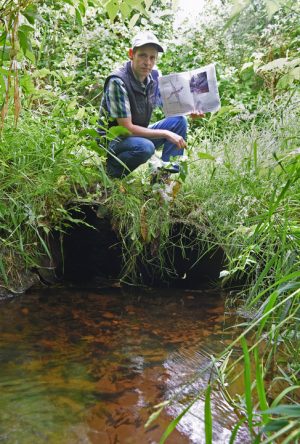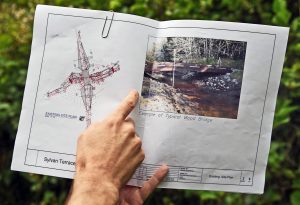www.ChehalisLeadEntity.org
News

Homeowners Association Leads Charge to Enhance its “Backyard” at Black Lake
Homeowners Association Leads Charge to Enhance its “Backyard” at Black Lake

John Wilson, a board member with the Sylvan Terrace Owners Association in Thurston County, displays plans for a bridge that will cross this portion of Michelle Creek through which now exists a three-pipe culvert that will be removed.
Submitted by Paul Dunn for Chehalis Basin Lead Entity
To John Wilson and others in the Sylvan Terrace Owners Association, the multi-acre splash of riparian and wetland area between their Olympia condominium complex and Black Lake is a little bit of paradise.
The site, they say — including Michelle Creek that bisects it — is a marvelous ode to nature’s bounties and the wildlife that call the land home. And because of that, Wilson and the Sylvan Terrace Owners Association are doing their best to preserve and enhance their unique backyard.
Wilson, 43, and Dorothy Zee — two of four people on the condo owners association board of directors — have been leading the charge. Their vision and dedication, along with the help of many others, will help ensure that the creek’s salmon are once again free to migrate through the waters. Because of human-made impediments, native salmon species including coho, Chinook, steelhead and cutthroat have not been seen in Michelle Creek for 15 to 20 years. The creek is a tributary to Black Lake and, farther on, to the Black River.
The main portion of the owners’ association project, which should begin soon and be complete in late August, will replace an existing three-pipe culvert with a modular 12-foot-wide by 30-foot-long, pressure-treated wooden bridge. About three months later, volunteers will help shore up the creek’s banks by planting approximately 1,200 willow stakes along the creek.
Removing the culvert should open about 100 acres of streambed for the site’s salmon population and help restore this mid-eastern portion of the mammoth Chehalis River Watershed.
Wilson can’t wait. He foresees a salmon revival.
“I’ve never been so excited for fall and all the rain to return,” he said. “I really want to see the fish return to the estuary.”
Key McMurry is confident, too. McMurry, a stream and wildlife biologist, owns Key Environmental Solutions, LLC, in Raymond. She has been working closely with the Sylvan Terrace Owners Association to figure out how to replace the constricting culvert, enhance the creek’s shores, and bring back its aquatic residents.
“I’m very confident that as soon as we open those barriers, fish will literally be flying up the creek next season,” she said. “That has been the case on almost all the barrier projects we have worked on over the years. The wetlands are awesome for salmon and other species. It provides connectivity with other waterways and access for the wildlife that live there.”

With McMurry’s guidance, the owners’ association board succeeded in obtaining a $96,908 Habitat Restoration Protection grant from the Chehalis Basin Strategy that should cover approximately all project expenses. The grant, received in late February, requires no monetary match from the owners’ association, an unusual circumstance.
“It’s really an extraordinary grant, and I think it underscores the importance of the Chehalis Watershed and the fact that we received it shows how beneficial our project will be,” said Wilson, an Olympia speech language pathologist when he’s not pulling environmental duty.
“In all my years of doing this type of work, I’ve never encountered a no-match grant in the salmon-restoration world,” McMurry said, noting the grant is for all aquatic species enhancement so applies to salmon, the Oregon spotted frog and the Olympic mudminnow that call the Michelle Creek area home. “The culvert desperately had to be replaced, and doing so will open up miles of wetlands for salmon in their wintering habitat.”
Though McMurry has provided much of the project assistance thus far and will continue as the bridge is constructed and creek banks revitalized, Wilson and the owners association are counting on some other volunteers to help out, too.
They’ll come primarily in the shape of about 30 Cub Scouts from Pack 007 from Lacey. Wilson expects another 20 or so people to augment the scouts as work gets going.
“For me it’s an opportunity to educate future generations about the importance of restoring natural habitat and ensure that different species will be around in the future,” Wilson said. “I like being out in the natural environment, and I’m looking forward to getting out there and making a difference.”
As far as McMurry’s concerned, Wilson and the owners association have already accomplished much. Without them, the project would never have gotten off the ground.
“Salmon restoration takes great, willing landowners who go out of their way to figure out how to make something happen,” she said. “You can’t do projects without willing landowners.”
Learn what the Sylvan Lake Homeowners’ Association is doing to improve the environment around them. Read full story here: http://www.thurstontalk.com/2016/06/22/salmon-restoration-black-lake/
Photos and story by Paul Dunn.

John Wilson, a board member with the Sylvan Terrace Owners Association in Thurston County, displays plans for a new wooden bridge that will extend accross this portion of Michelle Creek near the association’s condominium complex. The bridge will replace an existing three-pipe culvert that has impeded migration of the area’s native salmon.